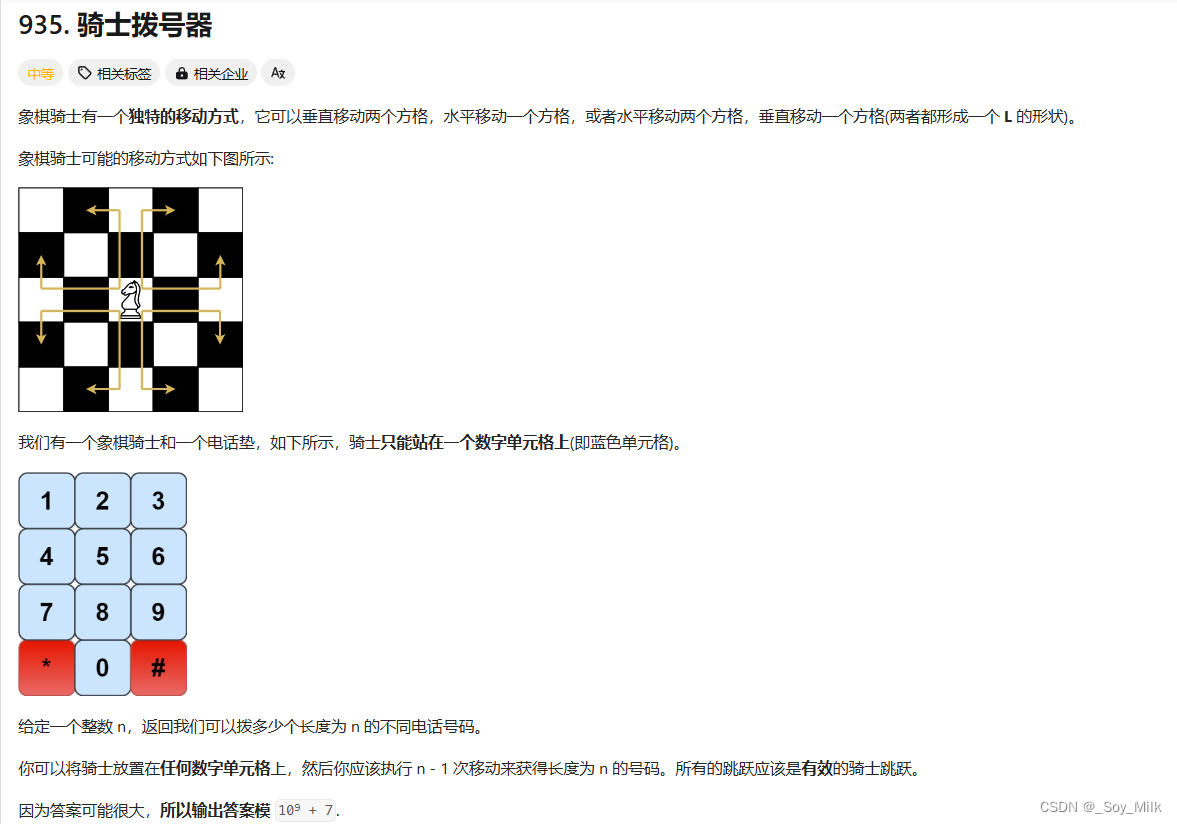935.骑士拨号器 - 力扣
题目链接:935. 骑士拨号器 - 力扣(LeetCode)
题目:

示例 1:
输入:n = 1 输出:10 解释:我们需要拨一个长度为1的数字,所以把骑士放在10个单元格中的任何一个数字单元格上都能满足条件。示例 2:
输入:n = 2 输出:20 解释:我们可以拨打的所有有效号码为[04, 06, 16, 18, 27, 29, 34, 38, 40, 43, 49, 60, 61, 67, 72, 76, 81, 83, 92, 94]示例 3:
输入:n = 3131 输出:136006598 解释:注意取模
题解:
题目大意:给定一个电话垫,不同数字之间的移动只能是L形状的路线(L可以旋转),并且只能在数字之间移动,求出长度为n的不同电话号码有多少个?
读完题目之后,一个很简单的思路就是模拟,使用暴力的方式来模拟这一过程,最初我是用的是深度优先搜索算法进行暴力求解,但是回出现栈溢出的情况,在输入N = 3131的时候,电脑内存爆满,导致电脑卡死,而后重启得以恢复。因此需要想出一个更加高效的方法,另一个思路就是——动态规划算法,我们可以定义dp[i][j],表示长度为i终点为数字j的电话号码个数,由于每一个数字能移动到其他数字的个数是有限的,我们可以将其列举出来:
| 终点数字 | 起点数字 |
|---|---|
| 0 | 4, 6 |
| 1 | 6, 8 |
| 2 | 7, 9 |
| 3 | 4, 8 |
| 4 | 3, 9, 0 |
| 5 | |
| 6 | 1, 7, 0 |
| 7 | 2, 6 |
| 8 | 1, 3 |
| 9 | 4, 2 |
可以发现只有数字5移动到其他数字上,并且其他数字也不能移动到数字5上,因此我们可以设置一个vector数组,将其都存储进去,然后在循环的时候进行遍历这个数组,表示每个值能从那个位置移动而来,如果每一个数字能移动其他数字上,那么反过来也是成立的。
const vector<vector<int>>fromNum = {{4, 6}, {6, 8}, {7, 9}, {4, 8}, {3, 9, 0}, {}, {1, 7, 0}, {2, 6}, {1, 3}, {4, 2}};
初始化数组,如果电话号码的长度为1,那么每一个数字都只不能移动,所以长度为1的每一个数字的值都为1。即:for(int i = 0; i < 10; i++) dp[1][i] = 1;
进行动态规划结束后,我们得到的是以每一个数字结尾的长度为n的电话号码个数,只需要将长度为N的每一个数字结尾的电话号码个数进行累加即可得到最终的答案(注意:还要进行取余)。
代码:
暴力求解:
该代码不能使用,会栈溢出,如果使用的话n的值不要超过17,如果超过17,就是不会使内存爆满,也会有漫长的等待时间。
# include<iostream>
# include<set>
# include<string>
using namespace std;
# define IOS ios::sync_with_stdio(0); cin.tie(0); cout.tie(0);
# define ll long long
const ll mod = 10e9 + 7;
// 定义工具
int x[8] = {2, 2, -2, -2, 1, -1, 1, -1}; // 左右
int y[8] = {-1, 1, -1, 1, -2, -2, 2, 2}; // 上下
int direction_number = sizeof(x) / sizeof(x[0]);
// 边界
int min_x = 0, min_y = 0;
int max_x = 2, max_y = 3;
int a[][3] = {
{1, 2, 3},
{4, 5, 6},
{7, 8, 9},
{-1, 0, -1}
};
set<string> answer;
void search(int n, string temp_string, int temp_number, int pos_x, int pos_y){
// cout<<temp_string<<endl;
// 如果达到了边界,就进行存入数据,并且返回。
if(temp_number == n){
answer.insert(temp_string);
// cout<<temp_string<<endl;
return ;
}
// 如果没有达到边界,就继续进行递归累加
// 一共有八种方向,每一个方向都进行尝试
for(int dire = 0;dire < direction_number; dire ++){
int temp_x = pos_x + x[dire];
int temp_y = pos_y + y[dire];
if(temp_x >= min_x && temp_x <= max_x && temp_y >= min_y && temp_y <= max_y){ // 判断是否越界
if(a[temp_x][temp_y] == -1) continue; // 只能遍历到数字
string num_to_string = to_string(a[temp_x][temp_y]);
search(n, temp_string + num_to_string, temp_number + 1, temp_x, temp_y);
}
}
return ;
}
void solve(){
// int n; cin>>n;
int n = 14;
int rows = sizeof(a) / sizeof(a[0]);
int colums = sizeof(a[0]) / sizeof(a[0][0]);
// 初始位置可以是任意一个数字的位置
for(int row = 0;row < rows; row++){
for (int colum = 0; colum < colums; colum ++){
if(row == 3 && colum == 0 || row == 3 && colum == 2) continue;
string num_to_string = to_string(a[row][colum]);
search(n, num_to_string, 1, row, colum);
}
}
cout<<answer.size() % mod<<endl;
// for(int row = 0;row < rows; row++){
// for (int colum = 0; colum < colums; colum ++){
// printf("%d ", a[row][colum]);
// }
//
// }
return ;
}
signed main(){
IOS int t = 1;
while(t--){
solve();
}
return 0;
}
动态规划:
调试代码:
#include<iostream>
#include<vector>
using namespace std;
# define IOS ios::sync_with_stdio(0); cin.tie(0); cout.tie(0);
# define ll long long
const ll mod = 1e9 + 7;
const vector<vector<int>>fromNum = {{4, 6}, {6, 8}, {7, 9}, {4, 8}, {3, 9, 0}, {}, {1, 7, 0}, {2, 6}, {1, 3}, {4, 2}};
void solve(){
// int n;cin>>n;
int N = 3131;
int ans = 0;
vector<vector<ll>>dp(N + 1, vector<ll>(10, 0));
// 初始化边界, 一次的电话号码个数
for(int i = 0; i < 10;i ++)dp[1][i] = 1;
// 进行动态规划, 从两次开始
for(int n = 2; n<= N;n ++){
for(int j = 0;j < 10; j++){
for(int from : fromNum[j]){
dp[n][j] = (dp[n][j] + dp[n - 1][from]) % mod;
}
}
}
// for(int i = 0;i <= N; i++){
// for(int j = 0;j < 10;j ++){
// cout<<dp[i][j]<<' ';
// }
// cout<<endl;
// }
for(int i = 0;i < 10;i ++) ans = (ans + dp.back()[i]) % mod;
cout<<ans<<endl;
return ;
}
int main(){
IOS int t = 1;
while(t--){
solve();
}
return 0;
}
提交代码:
class Solution {
public:
const long long mod = 1e9 + 7;
const vector<vector<int>>fromNum = {{4, 6}, {6, 8}, {7, 9}, {4, 8}, {3, 9, 0}, {}, {1, 7, 0}, {2, 6}, {1, 3}, {4, 2}};
int knightDialer(int N) {
// int N = 3131;
int ans = 0;
vector<vector<long long>>dp(N + 1, vector<long long>(10, 0));
// 初始化边界, 一次的电话号码个数
for(int i = 0; i < 10;i ++)dp[1][i] = 1;
// 进行动态规划, 从两次开始
for(int n = 2; n<= N;n ++){
for(int j = 0;j < 10; j++){
for(int from : fromNum[j]){
dp[n][j] = (dp[n][j] + dp[n - 1][from]) % mod;
}
}
}
for(int i = 0;i < 10;i ++) ans = (ans + dp.back()[i]) % mod;
return ans;
}
};